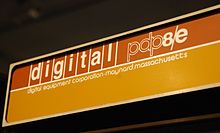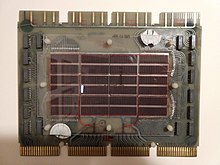PDP-8/e
 | |
 PDP-8/e at theLiving Computer Museumin Seattle, Washington | |
| Manufacturer | Digital Equipment Corporation |
|---|---|
| Product family | PDP-8 |
| Generation | 6th Generation |
| Release date | 1970 |
| Introductory price | $6,500 |
| Operating system | OS/8 |




ThePDP-8/ewas a model of thePDP-8line of minicomputers, designed by theDigital Equipment Corporationto be a general purpose computer that inexpensively met the needs of the average user while also being capable of modular expansion to meet the more specific needs of advanced user.[1]
Description
[edit]The first prototype was built in 1970, and was among the firstminicomputerssmall enough to fit in the back seat of aVolkswagen Beetle Convertible.[2]It originally sold for $6,500 but after 18 months the price was dropped to $4995 to make it the only computer under $5000 available at that time.[3]
The standard -8/e included a processor, core memory, a data terminal, a tape control and drive, a programmers table, a line printer, software operating system and when purchased included installation, training and maintenance as part of the purchase agreement.[4]
The PDP-8/e featured a processor with single-address fixed word length, parallel transfer computer using12-bit,two's complement arithmetic. The 1.2/1.4 microsecond cycle time provides a computation rate of 385,000 additions per second. It was built to be versatile and has a high capacityinput/outputthat supports more than 60 types ofperipherals.[1]It could be used for a variety of tasks, from keeping score atFenway Parkto monitoring stimuli to the brain during brain surgery atMassachusetts General Hospital.[5]
Basic system
[edit]The basic PDP-8/E system was a 10.5 x 19 x 24 inch[3] (6 rack unit) rackmount or table top unit that contained the processor, core memory, front panel controls ( "programmer's console" ), console terminal interface for use with an external data terminal, and 115 or 230 volt AC power supply.[6]
Peripherals
[edit]Processor options
[edit]- Extended Arithmetic Element - Enables the performance of complex arithmetic at high speeds
- FPP-12 Floating Point Processor - Provides a dual-processor capability for faster calculations
- Power Fail and Automatic Restart - Restores operation automatically after a power failure and protects the operating program
- Real-Time Clocks- Programmable, line frequency, or crystal controlled intervals
- MI8-E hardware bootstrap, an array of diodes allowing startup without manually toggling in the bootstrap via the front panel
Mass storage devices
[edit]- DECtapemagnetic tape drives
- RX01 8 inchfloppy diskdrives (256kB)
- RK05hard drive with removable cartridge (2.5 Mb). Left rack in photo
- Paper Tape Readers and Punches- Punches up to 50 characters a second, reads up to 300 characters per second
- Card Readers- Marked or punched cards read at 300 cards per minute
Display devices
[edit]- Video and Writing Tablets - Alphanumeric and graphic display point-plot displays; light pens; telephone line transmission
- Hard-CopyDevices - incremental plotters; line printers with 64- or 96-characters sets, 165 characters per second or 356 lines per minute
Data communications devices
[edit]- Synchronous Communications -Modeminterface for Bell 201- and 300-series modems or equivalent
- Asynchronous Communications- Serial-line interface at various send/receive Baud rates; single or double buffered interfaces\
- Automatic Calling Units - 10-Channel multiplexer
Laboratory devices
[edit]- Analog to Digital Converters
- Digital to Analog Converters
- Programmable Real-Time Clock
- Digital I/O
- Heathkit EU-801E Laboratory I/O buffered interface, provided a 12-bit wide data port to the PDP-8. Used by David Larsen (Virginia Tech) in his course to instruct researchers in interfacing minicomputers[7]
Terminals
[edit]- CRTand Data-Entry Terminals - Alphanumeric 16-character keyboards; standard telephone line transmission
- TeletypeTerminals - send and receive only; synchronous read and punch
- Hard-CopyTerminals - Serial or parallel interfaces
References
[edit]- ^abDigital Equipment Corporation (1971).PDP-8/E: Small Computer Handbook.University of California: Digital Equipment Corporation. p. 2-1.
- ^"Exhibits - Living Computer Museum".livingcomputermuseum.org.Archived fromthe originalon 2016-02-05.Retrieved2016-07-05.
- ^ab"PDP-8/E and PDP-8/M Computer Information".Online PDP-8 Home Page.Retrieved17 May2024.
- ^Newest Members of the Worlds most Popular Minicomputer Family.Maynard, Massachusetts: Digital Equipment Corporation. 1973.
- ^"DEC's Blockbuster: The PDP-8 - CHM Revolution".computerhistory.org.
- ^PDP-8/E PDP-8/M & PDP-8/F Small Computer Handbook.Digital Equipment Corporation. 1973. pp.2-1,2-3.Retrieved2018-08-22.
- ^David Larson (September 18, 2015)."PDP-8 Minicomputer Interfacing - How to connect your PDP-8 to the outside world 1972".
